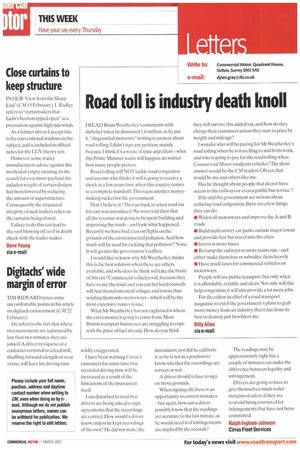Digitachs' wide margin of error
Page 28

If you've noticed an error in this article please click here to report it so we can fix it.
TIM RIDYARD raises some uncomfortable points in his article on digitach enforcement (CM 22 Februaiy).
He refers to the fact that where two movements are separated by less than two minutes, they are joined. A driver in a queue at a container terminal or a feed mill, shuffling forward a length or so at a time, will have his driving time wildly exaggerated.
I have been warning Cirrus's customers for some time that recorded driving time will be increased as a result of the limitations of the instrument itself.
lam disturbed to read that drivers are being asked to sign agreements that the recordings are correct. How would a driver know, unless he kept recordings of his own? He did not make the instrument, nor did he calibrate it, so he is not in a position to know whether the recordings are correct or not.
A driver should refuse to sign on those grounds.
When signing off, there is an opportunity to correct mistakes —but again, how can a driver possibly know that the readings are accurate to the last minute, as he would need to if infringements are implied by the records? The readings may be approximately right but a couple of minutes can make the difference between legality and infringement.
Drivers are going to have to give themselves much wider margins of safety if they are to avoid being convicted for infringements that have not been committed.
Ralph Ingham-Johnson Cirrus Fleet Services


























































































































































































